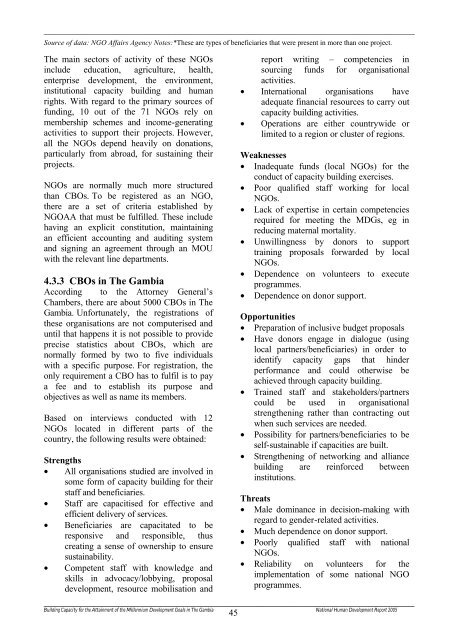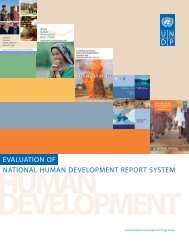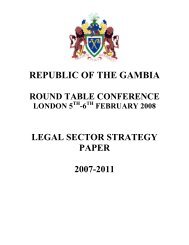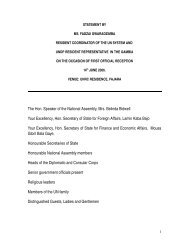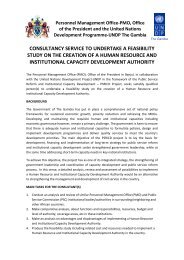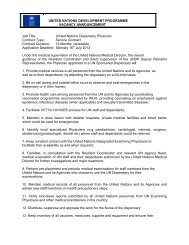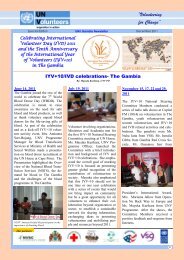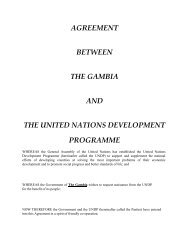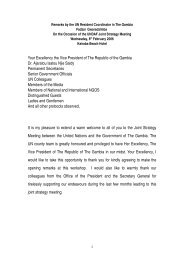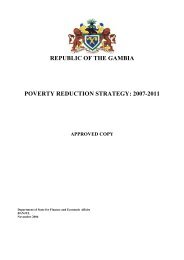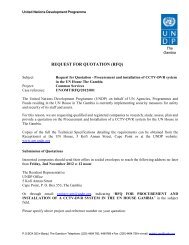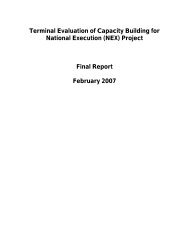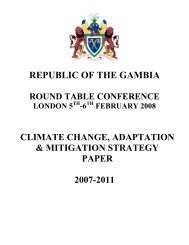Introduction - UNDP The Gambia
Introduction - UNDP The Gambia
Introduction - UNDP The Gambia
Create successful ePaper yourself
Turn your PDF publications into a flip-book with our unique Google optimized e-Paper software.
________________________________________________________________________________________________________________________<br />
Source of data: NGO Affairs Agency Notes:*<strong>The</strong>se are types of beneficiaries that were present in more than one project.<br />
<strong>The</strong> main sectors of activity of these NGOs<br />
include education, agriculture, health,<br />
enterprise development, the environment,<br />
institutional capacity building and human<br />
rights. With regard to the primary sources of<br />
funding, 10 out of the 71 NGOs rely on<br />
membership schemes and income-generating<br />
activities to support their projects. However,<br />
all the NGOs depend heavily on donations,<br />
particularly from abroad, for sustaining their<br />
projects.<br />
NGOs are normally much more structured<br />
than CBOs. To be registered as an NGO,<br />
there are a set of criteria established by<br />
NGOAA that must be fulfilled. <strong>The</strong>se include<br />
having an explicit constitution, maintaining<br />
an efficient accounting and auditing system<br />
and signing an agreement through an MOU<br />
with the relevant line departments.<br />
4.3.3 CBOs in <strong>The</strong> <strong>Gambia</strong><br />
According to the Attorney General’s<br />
Chambers, there are about 5000 CBOs in <strong>The</strong><br />
<strong>Gambia</strong>. Unfortunately, the registrations of<br />
these organisations are not computerised and<br />
until that happens it is not possible to provide<br />
precise statistics about CBOs, which are<br />
normally formed by two to five individuals<br />
with a specific purpose. For registration, the<br />
only requirement a CBO has to fulfil is to pay<br />
a fee and to establish its purpose and<br />
objectives as well as name its members.<br />
Based on interviews conducted with 12<br />
NGOs located in different parts of the<br />
country, the following results were obtained:<br />
Strengths<br />
• All organisations studied are involved in<br />
some form of capacity building for their<br />
staff and beneficiaries.<br />
• Staff are capacitised for effective and<br />
efficient delivery of services.<br />
• Beneficiaries are capacitated to be<br />
responsive and responsible, thus<br />
creating a sense of ownership to ensure<br />
sustainability.<br />
• Competent staff with knowledge and<br />
skills in advocacy/lobbying, proposal<br />
development, resource mobilisation and<br />
report writing – competencies in<br />
sourcing funds for organisational<br />
activities.<br />
• International organisations have<br />
adequate financial resources to carry out<br />
capacity building activities.<br />
• Operations are either countrywide or<br />
limited to a region or cluster of regions.<br />
Weaknesses<br />
• Inadequate funds (local NGOs) for the<br />
conduct of capacity building exercises.<br />
• Poor qualified staff working for local<br />
NGOs.<br />
• Lack of expertise in certain competencies<br />
required for meeting the MDGs, eg in<br />
reducing maternal mortality.<br />
• Unwillingness by donors to support<br />
training proposals forwarded by local<br />
NGOs.<br />
• Dependence on volunteers to execute<br />
programmes.<br />
• Dependence on donor support.<br />
Opportunities<br />
• Preparation of inclusive budget proposals<br />
• Have donors engage in dialogue (using<br />
local partners/beneficiaries) in order to<br />
identify capacity gaps that hinder<br />
performance and could otherwise be<br />
achieved through capacity building.<br />
• Trained staff and stakeholders/partners<br />
could be used in organisational<br />
strengthening rather than contracting out<br />
when such services are needed.<br />
• Possibility for partners/beneficiaries to be<br />
self-sustainable if capacities are built.<br />
• Strengthening of networking and alliance<br />
building are reinforced between<br />
institutions.<br />
Threats<br />
• Male dominance in decision-making with<br />
regard to gender-related activities.<br />
• Much dependence on donor support.<br />
• Poorly qualified staff with national<br />
NGOs.<br />
• Reliability on volunteers for the<br />
implementation of some national NGO<br />
programmes.<br />
________________________________________________________________________________________________<br />
Building Capacity for the Attainment of the Millennium Development Goals in <strong>The</strong> <strong>Gambia</strong> National Human Development Report 2005<br />
45


